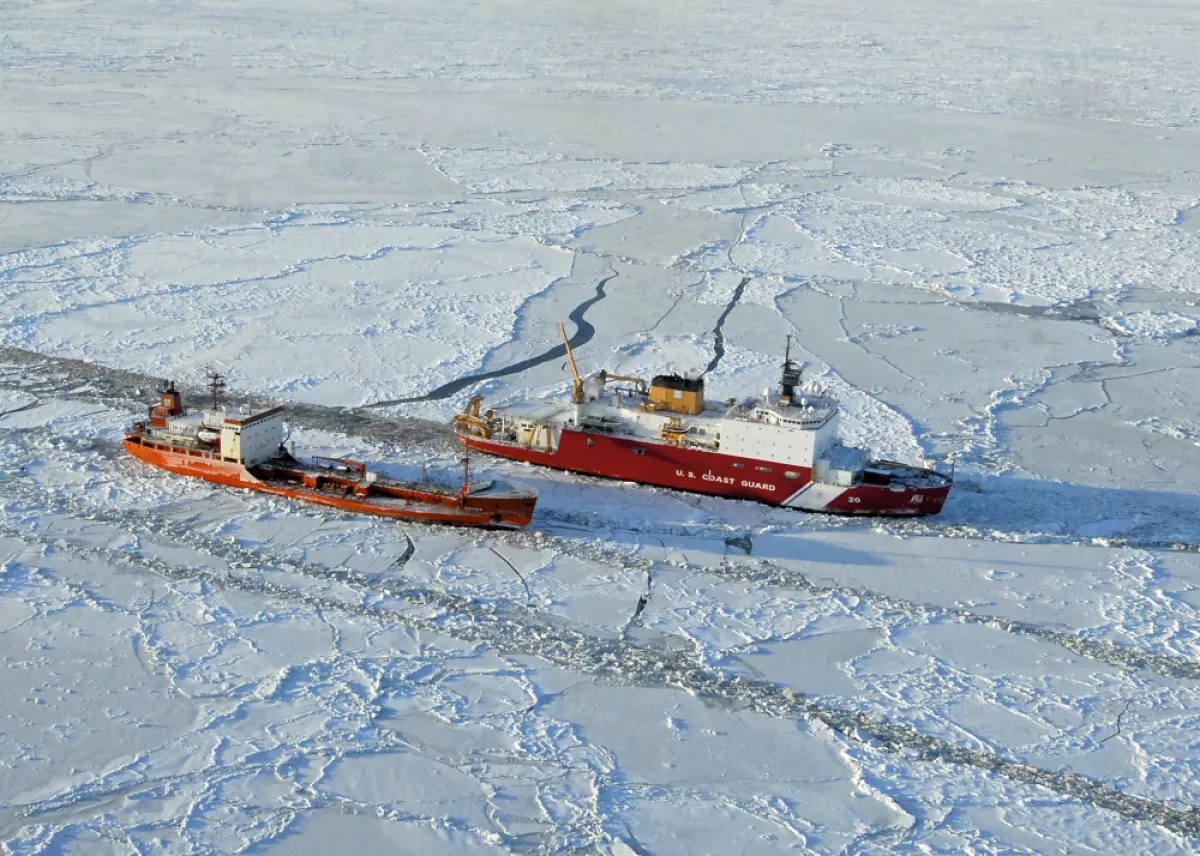An icebreaker is a specially designed ship or boat built to navigate and create safe passage through ice-covered waters for other vessels. While the term typically refers to larger ice-breaking ships, it can also encompass smaller vessels like those once used on UK canals.
1930: CGS N.B. McLean Launched
Addressing the need for icebreaking capabilities on the St. Lawrence River and in the Arctic, Canada launched the 80-meter steam icebreaker CGS N.B. McLean in 1930.
1933: Ymer: World's First Diesel-Electric Icebreaker
Marking a technological advancement, Sweden launched the world's first diesel-electric icebreaker, Ymer, in 1933, with a power output of 9,000 hp.
1939: Sisu: Finland's First Diesel-Electric Icebreaker
Following in Sweden's footsteps, Finland launched its first diesel-electric icebreaker, Sisu, in 1939.
1941: US Starts Wind-Class Icebreaker Construction
Drawing upon research from Scandinavia and the Soviet Union, the United States initiated the construction of the Wind-class icebreakers in 1941.
1952: CGS D'Iberville Launched
Continuing its commitment to icebreaking, Canada launched another large steam icebreaker, CGS D'Iberville, in 1952 for use in the St. Lawrence River and the Arctic.
1952: HMCS Labrador Begins Construction
In 1952, Canada started building HMCS Labrador, a diesel-electric icebreaker based on the USCG Wind-class design but without the bow propeller. This marked the start of diesel-electric icebreakers in Canada.
1957: NS Lenin Launched
In a groundbreaking achievement, the world's first nuclear-powered icebreaker, NS Lenin, was launched in 1957, ushering in a new era of icebreaking technology.
1957: Oden Surpasses Ymer
The commissioning of Oden in 1957 marked a shift in Swedish icebreaking power, surpassing the capabilities of the previous Ymer.
1959: NS Lenin Enters Operation
NS Lenin, the world's first nuclear-powered surface ship and the first nuclear-powered civilian vessel, commenced operation in 1959.
1959: Lenin: First Nuclear-Powered Icebreaker
The Soviet Union pioneered the development of nuclear-powered icebreakers with the commissioning of Lenin in 1959, featuring a nuclear-turbo-electric powertrain.
1960: CCGS John A. Macdonald Launched
Canada achieved a significant milestone in 1960 with the completion of CCGS John A. Macdonald, a considerably larger and more powerful ocean-going icebreaker than its predecessors.
1963: Yermak Decommissioned
In 1963, Icebreaker Yermak was officially decommissioned after a long and distinguished service.
1964: Yermak Scrapped
A year after its decommissioning, Icebreaker Yermak was scrapped in 1964, marking the end of its era.
1969: CCGS Louis S. St-Laurent Enters Service
Canada's largest and most powerful icebreaker, the CCGS Louis S. St-Laurent, was delivered in 1969, boasting a powerful steam turbine propulsion system.
1969: CCGS Louis S. St-Laurent Launched with Steam Turbines
The CCGS Louis S. St-Laurent, one of the few icebreakers equipped with steam boilers and turbogenerators, was launched in 1969. Later, it underwent a refit to incorporate diesel engines for better fuel efficiency.
1975: Arktika-Class Icebreakers Introduced
Starting in 1975, the Soviet Union introduced six Arktika-class nuclear icebreakers, solidifying its dominance in this technology.
1975: NS Arktika Commissioned
The Soviet Union continued its foray into nuclear-powered icebreakers with the commissioning of NS Arktika, the flagship of the Arktika class, in 1975.
1976: New Finnish Sisu Icebreaker
Finland replaced its older icebreaker with a newer, more capable vessel, also named Sisu, in 1976, demonstrating continuous development in icebreaking technology.
August 17, 1977: NS Arktika: First to the North Pole
In a historic achievement, NS Arktika became the first surface ship to reach the North Pole on August 17, 1977, underscoring the capabilities of nuclear-powered icebreakers.
1977: New Swedish Ymer Icebreaker
Sweden followed suit in 1977, replacing its older icebreaker Ymer with a new one bearing the same name, signifying ongoing advancements in icebreaker technology.
1987: Refit for CCGS Louis S. St-Laurent Begins
A major refit project for the CCGS Louis S. St-Laurent commenced in 1987, aiming to enhance its capabilities and extend its service life.
1989: NS Lenin Decommissioned
After a remarkable service period, NS Lenin was officially decommissioned in 1989.
1989: Keel Laying of NS Ural
The keel laying ceremony for NS Ural, which would later become NS 50 Let Pobedy, took place in 1989 at the Baltic Works of Leningrad.
1993: Launching of NS Ural
NS Ural, initially named as such, was launched in 1993, representing the continuation of the Arktika-class icebreakers.
1993: CCGS Louis S. St-Laurent's Refit Completed
The extensive refit of CCGS Louis S. St-Laurent, which included a new bow and a modern diesel-electric propulsion system, was completed in 1993, showcasing a commitment to maintaining a modern icebreaking fleet.
August 1994: North Pole Reached by North American Vessels
In a historic feat, Louis S. St-Laurent and USCGC Polar Sea became the first North American surface vessels to reach the North Pole in August 1994.
2000: Planned Decommissioning of Louis S. St-Laurent
The initial plan was to decommission the Louis S. St-Laurent in 2000. However, its service life was extended due to a refit.
May 2007: NS 50 Let Pobedy Completes Sea Trials
The nuclear-powered Russian icebreaker, originally named NS Ural but later renamed NS 50 Let Pobedy, successfully completed its sea trials in May 2007 and was put into service by the Murmansk Shipping Company.
2017: Decommissioning of Louis S. St-Laurent Postponed Again
The decommissioning of Louis S. St-Laurent was again postponed to 2017, highlighting its continued importance. It was decided that the vessel would be kept in service through the 2020s.
2020: New Generation of Russian Icebreakers
Russia, maintaining its legacy as the sole operator of nuclear-powered icebreakers, saw the first of its new 60,000 kW icebreakers enter service in 2020, replacing the aging Arktika class.
Mentioned in this timeline
The Union of Soviet Socialist Republics USSR existed from to...
Russia officially the Russian Federation is a transcontinental country spanning...
Canada is a North American country the second largest in...
Sweden officially the Kingdom of Sweden is a Nordic country...
Trending

1 month ago Widespread Flight Cancellations and Delays Ground Thousands of Passengers Across the US

10 days ago Candace Cameron Bure resists cancel culture, unveils new 'Rise and Renew' devotional.
1 month ago Six missing children found safe in Lancaster County after search by police.

7 months ago Randy Travis and Wife Invest in Jackson's Metrocenter Mall Revitalization Project.

7 months ago Gavin Newsom faces challenges in final term amid budget concerns and 2028 ambitions.

1 month ago Stallone Protected Himself with Body Armor for Snipes' Intense 'Demolition Man' Performance.
Popular

Candace Owens is an American conservative political commentator and author...

Ilhan Omar is an American politician currently serving as the...

XXXTentacion born Jahseh Dwayne Ricardo Onfroy was a controversial yet...

Tom Cotton is an American politician and Army veteran currently...
The Kennedy Center Honors are annual awards recognizing individuals and...

Kelsey Grammer is an accomplished American actor producer and singer...
